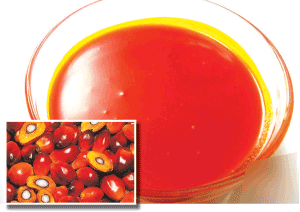Palm oil is an edible vegetable oil derived from the mesocarp (reddish pulp) of the fruit of the oil palm, primarily the African oil palm, Elaeis guineensis, and to a lesser extent from the American oil palm, Elaeis oleifera, and the maripa palm, Attalea maripa, according to Wikipedia.
 It is naturally reddish in colour, evidence of a high beta-carotene content. It has a balanced fatty acid composition in which the level of saturated fatty acids is almost equal to that of the unsaturated fatty acids.
It is naturally reddish in colour, evidence of a high beta-carotene content. It has a balanced fatty acid composition in which the level of saturated fatty acids is almost equal to that of the unsaturated fatty acids.
The low level of linoleic acid and virtual absence of linolenic acid make the oil relatively stable to oxidative deterioration. Palmitic acid (between 44 to 45 per cent) and oleic acid (39 to 40 per cent) are the major component acids. Linoleic acid is 10 to 11 per cent.
Several surveys conducted by Malaysian Palm Oil Board (MPOB) have shown that the Malaysian palm oil has a narrow compositional range.
The oil is unique among vegetable oils because it has a significant amount of saturated acids (10 to 15 per cent) at the two-position of its triglycerides. The appreciable amounts of disaturated (POP and PPO) and monosaturated (POO, OPO and PLO) allow it to be easily separated into two products; palm olein and palm stearin.
A wide range of fractions with different properties to suit requirements of the food industry, according to palmoilworld.org, is made available through dry fractionation.
Palm oil should not be confused with palm kernel oil (derived from the kernel of the same fruit) or coconut oil (derived from the meat of the coconut fruit). It is a common cooking ingredient in the tropical belt of Africa, south-east Asia and parts of Brazil.
Saturated fat found mostly in coconut oil, palm oil and palm kernel oil are the best for cooking. In contrast to what we all believe and what most dieticians would tell you, saturated fats are also the healthiest because they are more stable in nature and do not cause much inflammation in the body tissue when exposed to heat and light.
These common overlooked oils have little polyunsaturated fats and contain more of natural saturated fats which are not reactive under heat, light and pressure and hence no oxidation which cause the inflammation in body tissues.
Economic importance of palm oil
Obtained from the fruit (both the flesh and the kernel) of the oil palm tree, the red oil contributes to the economic development of the producing countries and to the diets of millions of people around the world. In fact, palm oil can be found in a huge percentage of every day supermarket products.
Palm oil is used as a cooking oil for all forms of stew and soups in Africa.
Health benefits
The deep red colour of palm oil is contributed by natural pigments called carotenoids. There are more than 600 different carotenoids known to exist in nature. Carotenoids have long been used as natural food colourants, as well as cosmetics.
Red palm oil is a natural plant source of carotenes in terms of retinol (vitamin A) equivalents, providing 7,000 retinol equivalents (RE) per 100 grammes. This is about 17 times as much beta-carotene as carrots.
Neuro-protection
A series of National Institutes of Health (NIH)-funded research that spanned over a decade showed that tocotrienols (as Tocomin SupraBio, from Carotech Inc.) support brain health by triggering and increasing blood circulation through collateral arteries to the area of the brain that suffered ischemic stroke.
In addition, oral supplementation with Tocomin SupraBio in human subjects showed tocotrienols are well absorbed and distributed to organs and tissues, such as the brain, liver, heart muscle, adipose tissue, blood and skin; reaching levels that more than enough to confer neuroprotection.
Liver health
A recent human clinical study completed at The Ohio State University Medical Center also reported that end-stage liver patients (those waiting for liver transplantation) supplemented with Tocomin SupraBio resulted in statistically significant protective effect.
Source of Vitamin A
Research has shown that consumption of red palm oil significantly enhanced vitamin A levels in humans, and it is beneficial in preventing vitamin A deficiency. Vitamin A deficiency may lead to blindness, skin disease and weakened immune function. (Culled from naturalproductsInsider.com)











